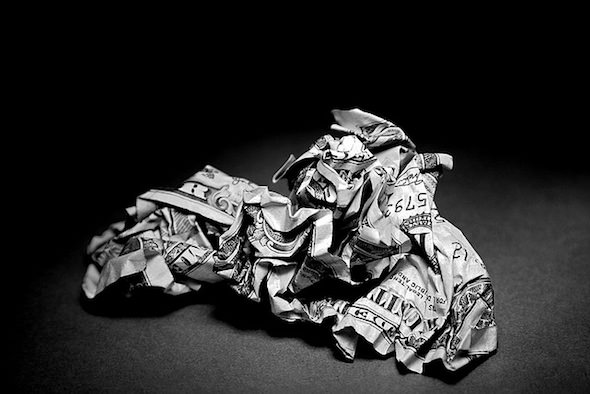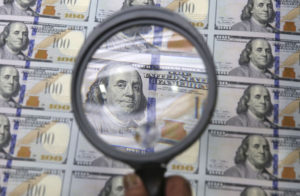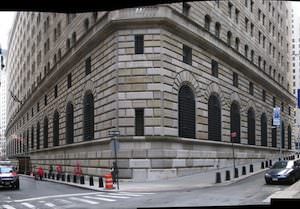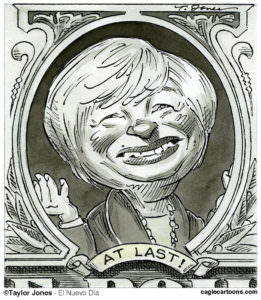Council on Foreign Relations: It’s Time to Rain Money on Main Street
The September/October issue of Foreign Affairs features an article titled “Print Less But Transfer More: Why Central Banks Should Give Money Directly To The People.” It’s the sort of thing normally heard only from money reformers and Social Credit enthusiasts far from the mainstream. What’s going on?
By Ellen Brown, Web of DebtThis piece first appeared at Web of Debt.
You can always count on Americans to do the right thing, after they’ve tried everything else. —Winston Churchill
When an article appears in Foreign Affairs, the mouthpiece of the policy-setting Council on Foreign Relations, recommending that the Federal Reserve do a money drop directly on the 99%, you know the central bank must be down to its last bullet.
The September/October issue of Foreign Affairs features an article by Mark Blyth and Eric Lonergan titled “Print Less But Transfer More: Why Central Banks Should Give Money Directly To The People.” It’s the sort of thing normally heard only from money reformers and Social Credit enthusiasts far from the mainstream. What’s going on?
The Fed, it seems, has finally run out of other ammo. It has to taper its quantitative easing program, which is eating up the Treasuries and mortgage-backed securities needed as collateral for the repo market that is the engine of the bankers’ shell game. The Fed’s Zero Interest Rate Policy (ZIRP) has also done serious collateral damage. The banks that get the money just put it in interest-bearing Federal Reserve accounts or buy foreign debt or speculate with it; and the profits go back to the 1%, who park it offshore to avoid taxes. Worse, any increase in the money supply from increased borrowing increases the overall debt burden and compounding finance costs, which are already a major constraint on economic growth.
Meanwhile, the economy continues to teeter on the edge of deflation. The Fed needs to pump up the money supply and stimulate demand in some other way. All else having failed, it is reduced to trying what money reformers have been advocating for decades — get money into the pockets of the people who actually spend it on goods and services.
A Helicopter Drop on Main Street
Blyth and Lonergan write:
[L]ow inflation . . . occurs when people and businesses are too hesitant to spend their money, which keeps unemployment high and wage growth low. In the eurozone, inflation has recently dropped perilously close to zero. . . . At best, the current policies are not working; at worst, they will lead to further instability and prolonged stagnation.
Governments must do better. Rather than trying to spur private-sector spending through asset purchases or interest-rate changes, central banks, such as the Fed, should hand consumers cash directly. In practice, this policy could take the form of giving central banks the ability to hand their countries’ tax-paying households a certain amount of money. The government could distribute cash equally to all households or, even better, aim for the bottom 80 percent of households in terms of income. Targeting those who earn the least would have two primary benefits. For one thing, lower-income households are more prone to consume, so they would provide a greater boost to spending. For another, the policy would offset rising income inequality. [Emphasis added.]
A money drop directly on consumers is not a new idea for the Fed. Ben Bernanke recommended it in his notorious 2002 helicopter speech to the Japanese who were caught in a similar deflation trap. But the Japanese ignored the advice. According to Blyth and Lonergan:
Bernanke argued that the Bank of Japan needed to act more aggressively and suggested it consider an unconventional approach: give Japanese households cash directly. Consumers could use the new windfalls to spend their way out of the recession, driving up demand and raising prices.
. . . The conservative economist Milton Friedman also saw the appeal of direct money transfers, which he likened to dropping cash out of a helicopter. Japan never tried using them, however, and the country’s economy has never fully recovered. Between 1993 and 2003, Japan’s annual growth rates averaged less than one percent.
Today most of the global economy is drowning in debt, and central banks have played all their other cards. Blyth and Lonergan write:
It’s well past time, then, for U.S. policymakers — as well as their counterparts in other developed countries — to consider a version of Friedman’s helicopter drops. In the short term, such cash transfers could jump-start the economy. Over the long term, they could reduce dependence on the banking system for growth and reverse the trend of rising inequality. The transfers wouldn’t cause damaging inflation, and few doubt that they would work. The only real question is why no government has tried them.
The Hyperinflation Bugaboo
The main reason governments have not tried this approach, say the authors, is the widespread belief that it will trigger hyperinflation. But will it? In a Forbes article titled “Money Growth Does Not Cause Inflation!”, John Harvey argues that the rule as taught in economics class is based on some invalid assumptions. The formula is:
MV = Py
When the velocity of money (V) and the quantity of goods sold (y) are constant, adding money (M) must drive up prices (P). But, says Harvey, V and y are not constant. The more money people have to spend (M), the more money that will change hands (V), and the more goods and services that will get sold (y). Only when V and y reach their limits – only when demand is saturated and productivity is at full capacity – will consumer prices be driven up. And they are nowhere near their limits yet.
The US output gap – the difference between actual output (y) and potential output – is currently estimated at about $1 trillion annually. That means the money supply could be increased by at least $1 trillion without driving up prices.
As for V, the relevant figure for the lower 80% (the target population of Blyth and Lonergan) is the velocity of M1 –– coins, dollar bills, and checkbook money. Fully 76% of Americans now live paycheck to paycheck. When they get money, they spend it. They don’t trade in the forms of investment called “near money” and “near, near money” that make up the bulk of M2 and M3.
The velocity of M1 in 2012 was 7 (down from a high of 10 in 2007). That means M1 changed hands seven times during 2012 – from housewife to grocer to farmer, etc. Since each recipient owes taxes on this money, increasing GDP by one dollar increases the tax base by seven dollars.
Total tax revenue as a percentage of GDP in 2012 was 24.3%. Extrapolating from those figures, one dollar spent seven times over on goods and services could increase tax revenue to the government by 7 x 24.3% = $1.7. The government could actually get more back in taxes than it paid out! Even with some leakage in those figures, the entire dividend paid out by the Fed might be taxed back to the government, so that the money supply would not increase at all.
Assume a $1 trillion dividend issued in the form of debit cards that could be used only for goods and services. A back-of-the-envelope estimate is that if $1 trillion were shared by all US adults making under $35,000 annually, they could each get about $600 per month. If the total dividend were $2 trillion, they could get $1,200 per month. And in either case it could, at least in theory, all come back in taxes to the government without any net increase in the money supply.
There are also other ways to get money back into the Treasury so that there is no net increase in the money supply. They include closing tax loopholes, taxing the $21 trillion or more hidden in offshore tax havens, raising tax rates on the rich to levels like those seen in the boom years after World War II, and setting up a system of public banks that would return the interest on loans to the government. If bank credit were made a public utility, nearly $1 trillion could be returned annually to the Treasury just in bank profits and savings on interest on the federal debt. Interest collected by U.S. banks in 2011 was $507 billion (down from $725 billion in 2007), and total interest paid on the federal debt was $454 billion.
Thus there are many ways to return the money issued in a national dividend to the government. The same money could be spent and collected back year after year, without creating price inflation or hyperinflating the money supply.
Why It’s the Job of the Fed
Why not just stimulate employment through the congressional funding of infrastructure projects, as politicians usually advocate? Blyth and Lonergan write:
The problem with these proposals is that infrastructure spending takes too long to revive an ailing economy. . . . Governments should . . . continue to invest in infrastructure and research, but when facing insufficient demand, they should tackle the spending problem quickly and directly.
Still, getting money into the pockets of the people sounds more like fiscal policy (the business of Congress) than monetary policy (the business of the Fed). But monetary policy means managing the money supply, and that is the point of a dividend. The antidote to deflation – a shrinking supply of money – is to add more. The Fed tried adding money to bank balance sheets through its quantitative easing program, but the result was simply to drive up the profits of the 1%. The alternative that hasn’t yet been tried is to bypass the profit-siphoning 1% and get the money directly to the consumers who create consumer demand.
There is another reason for handing the job to the Fed. Congress has been eviscerated by a political system that keeps legislators in open battle, deadlocked in inaction. The Fed, however, is “independent.” At least, it is independent of government. It marches to the drum of Wall Street, but it does not need to ask permission from voters or legislators before it acts. It is basically a dictatorship. The Fed did not ask permission before it advanced $85 billion to buy an 80% equity stake in an insurance company (AIG), or issued over $24 trillion in very-low-interest credit to bail out the banks, or issued trillions of dollars in those glorified “open market operations” called quantitative easing. As noted in an opinion piece in the Atlantic titled “How Dare the Fed Buy AIG”:
It’s probable that they don’t actually have the legal right to do anything like this. Their authority is this: who’s going to stop them? No one wants to take on responsibility for this mess themselves.
There is a third reason for handing the job to the Fed. It is actually in the interest of the banks – the Fed’s real constituency – to issue a national dividend to the laboring masses. Interest and fees cannot be squeezed from people who are bankrupt. Creditor and debtor are in a symbiotic relationship. Like parasites and cancers, compound interest grows exponentially, doubling and doubling again until the host is consumed; and we are now at the end stage of that cycle. To keep the host alive, the creditors must restock their food source. Dropping money on Main Street is thus not only the Fed’s last bullet but is a critical play for keeping the game going.
Ellen Brown is an attorney, founder of the Public Banking Institute, and author of twelve books, including the best-selling Web of Debt. In The Public Bank Solution, her latest book, she explores successful public banking models historically and globally. Her 200+ blog articles are at EllenBrown.com.
Your support is crucial...As we navigate an uncertain 2025, with a new administration questioning press freedoms, the risks are clear: our ability to report freely is under threat.
Your tax-deductible donation enables us to dig deeper, delivering fearless investigative reporting and analysis that exposes the reality beneath the headlines — without compromise.
Now is the time to take action. Stand with our courageous journalists. Donate today to protect a free press, uphold democracy and uncover the stories that need to be told.






You need to be a supporter to comment.
There are currently no responses to this article.
Be the first to respond.